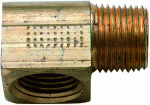Re: After Market Fuel Tank Question
Unfortunately it has become a common myth in the boating world that an anti-siphon valve is always required. That ain't necessarily so. The anti-siphon valves is only required if the fuel outlet on the tank is higher than the fuel inlet on the engine. If the fuel outlet is lower than than fuel inlet on the engine then the fuel can't self siphon itself out of the tank. Plus that, if this is an outboard then the anti-siphon is not required by the USCG. It is recommended for outboards by ABYC but the same rules apply. The system has to be capable of siphoning itself out. Since this is a bow mounted tank that may be the situation, but each case has to be looked at separately. It is not a blanket rule for all boats.
Here is the regulation:
Sec. 183.568 Anti-siphon protection. Each fuel line from the fuel tank to the fuel inlet connection on the carburetor must:
(a) Be above the level of the tank top; or
(b) Have an anti-siphon device or an electrically operated fuel stop valve:
(1) At the tank withdrawal fitting; or
(2) Installed so the line from the fuel tank is above the top of the tank; or
(c) Provided that the fuel tank top is below the level of the carburetor inlet, be metallic fuel lines meeting the construction requirements of Sec. 183.538 or ``USCG Type A1'' hose, with one or two manual shutoff valves installed as follows:
(1) Directly at the fuel tank connection arranged to be readily accessible for operation from outside of the compartment, and
(2) If the length of fuel line from the tank outlet to the engine inlet is greater than 12 feet, a manual shutoff valve shall be installed at the fuel inlet connection to the engine




















